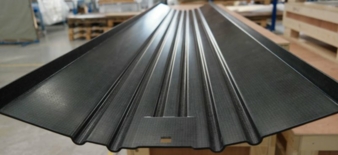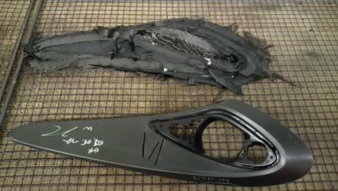23/05/2019 – RecyCarb — auf Deutsch lesen
From waste back into component
In the research project RecyCarb, a team of two institutes and four industrial partners has established a qualified value chain for recycled carbon fibers (rCF).
It was shown that fibres out of different waste streams can once again used as high quality and sustainable composite parts in sophisticated components. As part of the BMBF-funded project FutureTex, RecyCarb has focused on the topic of high-quality reuse of recycled carbon fibers, which had previously been insufficiently highlighted in many facets.
The aim
The aim was to close the technological gap of the waste stream from the textile chain or composite production for reuse in composite components. In the chosen holistic approach, waste materials were initially collected by the industrial partners involved. The amount of carbon fiber reinforced plastics (CFRP) was in a first step processed via pyrolysis by CFK Valley Stade Recycling GmbH & Co. KG, Wischhafen, in order to recover the carbon fibers.
The other part – textile waste materials – could be processed directly at the Saxon Textile Research Institute (STFI) without any intermediate steps using cutting and tearing technology. The obtained recycled fibres were processed as 100 percent raw material and also in blends with thermoplastic staple fibres (e.g. PA6) by airlay and carding principle.
The entanglement to nonwoven fabrics
The entanglement to nonwoven fabrics was carried out by needle-punching or stitch-bonding. Parallel to the developments of the textile semi-finished products by STFI and the industrial partner Tenowo GmbH, Hof, a comprehensive quality monitoring system was set up by the Faserinstitut Bremen. It considered the inspection of the recycled fibers as raw material, the sampling and measurement after different process steps and the quality control of the finished product.
Online monitoring system
Special attention was paid also to an online monitoring system. For example, for the first time the fiber orientation in carbon fiber nonwovens could already be measured during production by a camera system. The measurement of the fiber orientation as a ratio of machine to cross direction thereby enables the prediction of the strength ratio in the later CFRP and thus, forms the basis for component-specific design processes.
The further processing of the developed nonwovens into fiber composite materials finally took place at the industrial partners Schmuhl Faserverbundtechnik GmbH & Co. KG, Liebschütz, as well as Eissmann Cotesa GmbH, Mittweida, with standard market procedures. In addition to classical pressing methods, the RTM method and the autoclave technology using prepregs were also utilized. The focus was on the application areas of sports and leisure, medical technology as well as the automotive and the aviation industry.
Results
As a result of the investigations tangible applications for the textile semi-finished products made from recycled carbon fibers were identified. A selection of the possible fields of application is shown by the demonstrators created during the project. For example should be mentioned a bicycle saddle consisting of rCF nonwoven fabric with thermoplastic matrix. Also interesting applications were found for rCF nonwoven prepregs in combination with carbon woven structures. Demonstrated was this in an automotive rear spoiler with exposed carbon optics. The nonwoven prepregs are used for the substructure (non-visible surface) and the woven structure on top is responsible for the typical carbon look. A couch of a CAT-Scan with layers of rCF nonwovens instead of woven structures demonstrates applications in the medical sector.
At the recent international composite exhibition JEC 2019 in Paris, the demonstrators mentioned aroused great interest.
More detailed information on the project including results of the determination of semi-finished products and composites can be found in the TourAtlas for the project RecyCarb. Pleas click HERE.
Acknowledgment STFI and Faserinstitut Bremen
We thank the Federal Ministry of Education and Research for the promotion of the project RecyCarb under the grant number 03ZZ0608I.
Author: Marcel Hofmann (STFI)?, co-authors: Katharina Heilos (STFI) and Dr. Holger Fischer (Faserinstitut Bremen)





